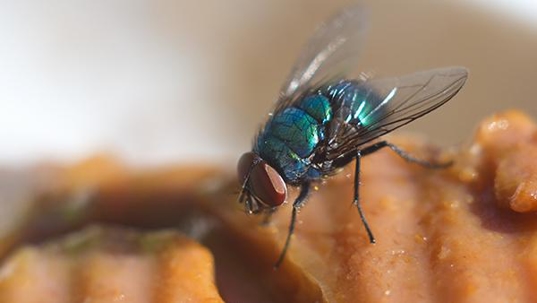The common house fly (Musca domestica Linnaeus) is a bothersome pest both indoors and outdoors. Experts suggest that house flies originated in Asia and have since expanded their presence throughout most parts of the world. Flies usually swarm animal feces, garbage, and other rotting food or organic materials.
One category of flies that often enter homes is large filth flies. Some of the types within this category include common house flies, cluster flies, and blow flies. Large filth flies are distinct from small filth flies, which include drain flies and fruit flies.
Has your property become a haven for flies? Contacting a licensed pest control professional is the best means of responding to these types of pest-related concerns. A well-qualified Houston pest control company understands the best ways to get rid of flies that enter homes and knows how to keep flies away.
Characteristics Of Common Flies
The house fly and most other species encountered indoors measure up to ¼ of an inch and usually appear in shades of grey and black. The thorax of the house fly has four stripes, and their bodies contain small hairs that provide these pests with sensory capabilities such as taste. Inside homes, flies often rest on window ledges, walls, and ceilings.
Where do house flies lay eggs? Female house flies often lay eggs in places with moisture, such as open trash bags or house plants. The eggs look similar to white rice and may appear in small groups. A female fly may generate hundreds of eggs in as little as one week.
The eggs often typically hatch a day later and transition into larvae in the form of tiny, white, worm-like maggots. Next, flies enter a pupae stage, forming a hard cocoon before finally emerging as adults.
The Health Hazards Of Flies In Your Home
Although the majority of flies that enter homes are considered nuisance pests, fly activity indoors may pose some risks to human health, such as:
- Flies may carry a host of pathogens and often will land on plates of food as we eat, utensils, and other areas.
- Although it might be difficult to see with the naked eye, flies sometimes vomit and defecate on indoor surfaces.
- Experts suggest that house flies may spread more than 60 various illnesses.
- Among the most common concerns associated with flies include cholera, salmonellosis, and typhoid.
Homeowners should diligently prevent flies from entering their homes based on the possible health risks. Some of the best practices include keeping drains clean, always storing trash bags containing food scraps in containers with a functional lid, and adopting excellent cleaning habits.
Why It Can Be Difficult To Get Rid Of Flies On Your Own
How do flies get in the house? Based on their small size and speed, flies often enter homes through torn window screens and swinging doors. Once indoors, people often struggle to get rid of these pests.
Too many property owners purchase do-it-yourself pest control products from online retailers or local stores. These mass-marketed options include aerosol sprays, traps, and many more. Stores typically market these products using exaggerated claims of effectiveness, yet they deliver underwhelming results that simply prolong aggravation. A better option involves consulting with a local pest control expert.
Professional Pest Control Makes For The Best Fly Control
The team of experts with All-Safe Pest & Termite understands the behavior of different species of flies and how to get rid of flies indoors. In addition to flies, our technicians will solve problems involving ants, cockroaches, fleas, and many other troublesome and potentially harmful pests. We will deploy a team member to your home who performs a detailed property inspection and will explain the best available treatment options.

